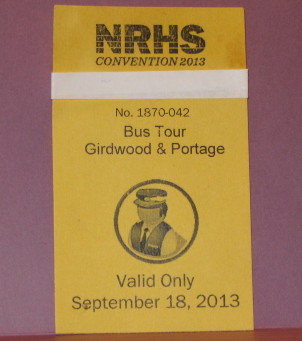In the dark of the morning,
the alarm sounds off. This is the start of my first morning here
in Alaska's largest city.
It was still a few minutes before the crack of dawn when my
timbers were shaken. After a few moments I realized what
happened. When your near neighbor is Elmendorf Air Force
Base, Alaska's largest Air Force base and home to 23,000 people
and a few moose, afterburners on the jet engines were turned on
and the pilots were getting ready to go out on patrol. This is a
NORAD base and of course you know that I can see Russia from my
hotel window high atop the Guest House or the jet mechanics just
wanted to give the neighbors a friendly wake up call.
For breakfast this morning, I went across the
street to Sizzlin Cafe which was highly recommend by the
informative hotel desk clerk last evening. Had a great ham and
eggs with coffee while watching the crack of dawn (cod).
Today was a bum day. No train rides today.
Not one.
This was the first day of the convention with
a day of varied activities in Anchorage, including:
Alaska RR depot and operations center tours. Sold Out.
Alaska RR shops tour. Sold Out.
or
Railroad and rail history seminars
NRHS Advisory Council meeting
NRHS Annual meeting of the Membership
or
Full day bus tour to Girdwood and Portage.
So I was doing the bus tour leaving the Hilton Hotel at 8:30 AM.
Leaving my hotel a few minuets before eight, I walked down 5th
Ave, one of the main drags in town to the Hilton. Arriving about
15 after, I find and board the bus. It is nearly full save about
half a dozen seats. Our bus guide and director today was the
"Lunch Princess," Sarah Jennings. Also on board was Elizabeth A.
My ticket to ride.
At 8:30 the bus left and we were under way. The driver gave his
narration as we traveled south thru the city.
Perched on the Knik Arm of the Cook Inlet and
framed by the Chugach Mountain Range, Anchorage began as a
railroad construction base in 1913, saw a post office open in
1914, and boom times through both World War I and II as military
staging city. Anchorage has grown into Alaska's center for
finance and industry. It is the state's largest city with more
than 275,000 people. Because it is protected by the Kenai
Mountains, Anchorage is relatively dry, receiving only 15.9
inches of precipitation and 69 inches of snow yearly.
Anchorage is an important community in world
freight movements. Approximately 90 percent of the consumer
goods for Alaska flow through either the port or the airport.
The Ted Stevens Anchorage International Airport is the third
busiest freight airport in the United States (behind FedEx in
Memphis and UPS in Louisville) and among the top ten in the
world. It has long been a refueling and freight consolidation
center for flights from around the world. For passengers, there
are more than 280 flights daily, handling more than 5 million
passengers a year.
After being in Anchorage a short time,
you come to realize that time here in measured by the 1964
Easter earthquake. Before and after.
The driver pointed out the grassy hillside park south of the
train station and across from the Hilton was a result of the
quake. The buildings were in rubble then the land was cleared
and became a park. The driver also talked about a local city
zone ordnance that in the downtown historic core that fast food
and chain restaurants are banned. They wanted to maintain the
small mom and pop style businesses so the town didn't look like
all the other main streets in every town in the country and the
wold. So if you need your fix from the big chain you have to go
to the suburb were they are welcome. Also the money you spend
with local businesses stays in the local area.
It wasn't long before we left the city and
were on the Seward Highway going south. The first portion of the
Seward Highway was completed in 1923, and the highway was
finished on October 9, 1951. The entire highway was paved in
1952. It became a US Forest Service scenic byway in 1989 and was
designated as an All-American Road in 2000. The highway
stretches from Anchorage south to Seward. The highway and the
Alaska Railroad tracks run parallel here along the bank of the
Turnagain Arm.
Turnagain Arm was named by William Bligh of
HMS Bounty fame. At the time, Bligh served as Captain Cook's
Sailing Master on his 3rd and final voyage, with the aim to
discover the Northwest Passage. Hunting for the Passage, Bligh
was of the opinion that Turnagain Arm was the mouth of a river
and not the opening to the Northwest Passage. However, Cook
ordered a full search of the area. Upon this party's return,
Bligh's frustration led him to name the bay the disingenuous
name "Turn Again," thus Turnagain Arm.
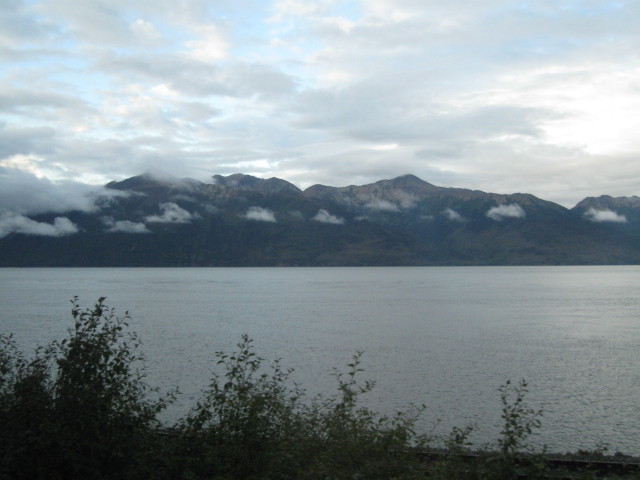
Turnagain Arm
About a hour out from the hotel, we passed several fields with
dead trees. The driver explained that this was the result of the
1964 earthquake that flooded the land with salt sea water. The
trees are now in a state of being petrified.
At about 10:00 am we arrived at out first
venue for the day. We are at the Portage Glacier and Portage
Lake. Portage got its name by being on the portage route from
the Gulf of Alaska to Cook Inlet.
Portage Glacier is considered by some to be
Alaska's most visited tourist attraction. The Begich-Boggs
Visitor Center provides information on the Portage Glacier area.
Portage Glacier was a local name first recorded in 1898 by
Thomas Corwin Mendenhall of the U.S. Coast and Geodetic Survey,
so-called because it is on a portage route between Price William
Sound and Turnagain Arm.
The glacier has been receding for a number of
years. In the last few years the glacier face has begun
retreating from the lake it created. A small section in the
center has exposed bedrock but much of the glacier face is still
in the water and extends down more than 100 feet into Portage
Lake. Portage Glacier is still considered a valley glacier.
Nearby are several hanging glaciers; that is, glaciers that come
part way down a mountainside. Glaciers that reach the sea are
called tidewater glaciers and glaciers that end in lakes are
also called freshwater glaciers. Portage Lake was created behind
the terminal moraine of Portage Glacier as it began receding.
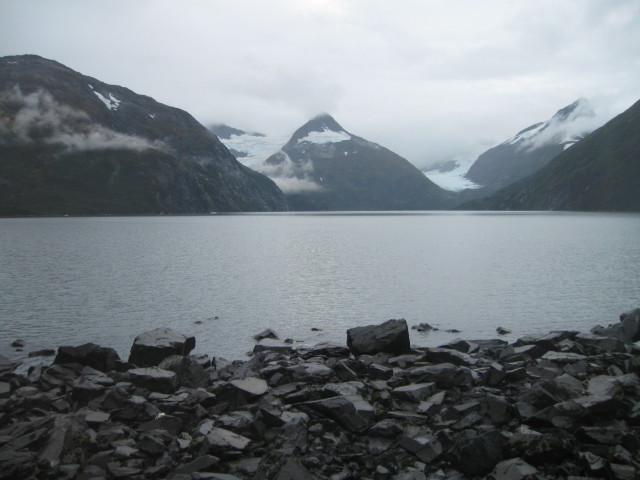
Portage Lake
As our bus pulled into an empty parking
lot and parked near the Visitors Center, everyone noticed the
big "Closed" sign at the entrance doors. Boy did the tongues
start to wag. Sarah J. got off the bus and walked to the
entrance and the doors were open to greet her. Several minutes
later she came back on our bus and explained that the Visitors
Center had closed for the season last weekend but the rangers
agreed to come from their posts and open the center for just us
special people. We were welcomed inside and given a short
welcome talk by the rangers and then lead into the theater to
watch a short film of local history and some earthquake footage.
At the end of the film, I think the front curtains were to open
and reveal big windows over looking the lake and glacier. It
didn't but several of us went up to curtain and pulled it back
to see behind the curtain. Having seen a similar presentation at
Ft. McHenry Nat'l Monument, I highly recommend a visit to it and
the B&O Railroad museum if you are near Baltimore, MD.
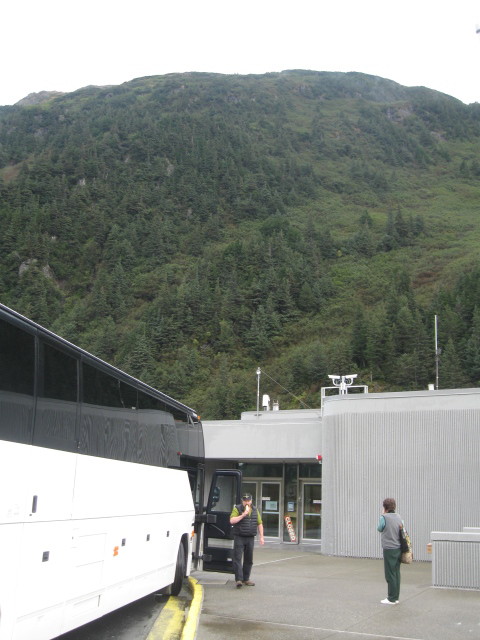
Our bus and driver at Visitors Center
Begich, Boggs Visitor Center
Open to the public in 1986, and rededicate
with new exhibits in 2001, the Begich, Boggs Visitor Center is
built upon the terminal moraine left behind by Portage Glacier
in 1914. The visitor center offers an unique opportunity to
learn about the Chugach (CHEW-gatch) National Forest, America's
second largest national forest, roughly as large as New
Hampshire.
The visitor center is named after Congressmen Nick Begich of
Alaska and Hale Boggs of Louisiana. They, along with their pilot
Dan Janz, and congressional aide Russell L. Brown, disappeared
in 1972 en route to Juneau from Anchorage. They were last heard
from as they flew over Portage Pass. No sign of the men or their
plane has ever been found. Congressman Boggs is the father of TV
news personality and author Cokie Roberts.
GPS: 60 47.064, -148
50.497
Click
for map Click Back button on your
browser to return to this page.
Moraines
Large piles of rock and debris are deposited
by glaciers as they flow down, or retreat from, valleys. In
fact, the visitor center is built on a terminal (end) moraine
that was deposited by Portage Glacier between the late 1890's
and 1914, when it began its most recent retreat.
Silt
The unique milky blue coloration of Portage
Lake and Portage Creek is due to the silt or rock flour that
stays suspended in the water. As glaciers move over the
landscape, the rocks they pick up along the way grind against
the mountainsides, creating the fine dust-like particles.
Why is the Ice Blue?
Glacier ice is formed under the weight of
countless snowfalls, which squeezes out most of the air, leaving
dense, compact ice. Sunlight, or white light, is made up of all
colors of the spectrum - with each color having a different
amount of energy. In regular ice, like the ice in your freezer,
the air bubbles scatter the light - creating the white
appearance. When sunlight strikes glacier ice, the lower energy
colors are absorbed by the ice and only the blue color, which
has the most energy, is reflected back to the eye!
First of several tunnels on the road to
Whittier and Prince William Sound.
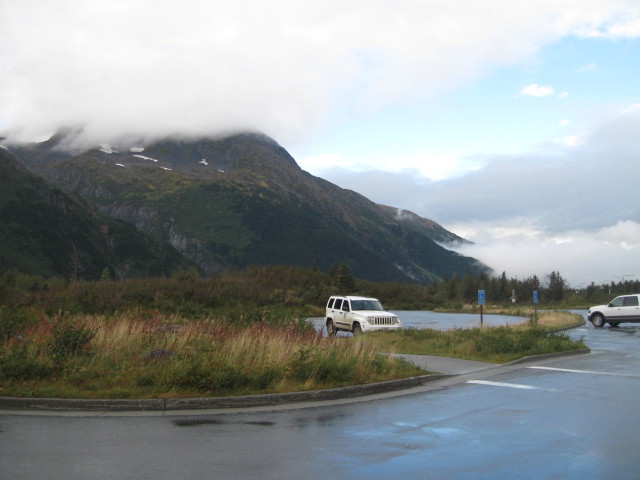
Parking lot at the visitors center.
After about an hour it was time to re-board our bus for a short
trip to our next venue.
Shortly after leaving we rejoined the Seward
Highway and then a few minutes later we were arriving at the
Alaska Wildlife Conservation Center (AWCC) is "a nonprofit
organization dedicated to preserving Alaska's wildlife through
conservation, public education, and quality animal care. AWCC
takes in injured and orphaned animals year-round and provides
spacious enclosures and quality animal care. Animals that cannot
be released into the wild are given a permanent home at the
center."
Since its founding, more than 3 million
people have visited the wildlife center. As its fame spreads,
attendance has increased to the point that annual visitation is
now over a quarter of a million people. Located west of the
railroad tracks in Portage (south of Girdwood) on 170 acres, the
facility provides a unique opportunity to see and photograph
many Alaskan animals including brown (grizzly) and black bears,
coyotes (see them in the bear enclosures where they keep up
their scavenging skills), moose, elk, musk ox, wood bison, sitka
deer, caribou, lynx and porcupine. All of the large mammals are
in enclosures covering acres of land, allowing them to wander in
their natural habitat. The AWCC continues to expand and is
building new enclosures to provide better viewing of the
animals.
When we arrive at the entrance gate, we are
informed that the free shuttle that would take you around to
different areas was not operating today so it was walking on
your own to get around. Not good for people unable to walk.
Those of us who could walk were let off to scout out the center
at their leisure. Just be back at the bus for 12:30 pm
departure.
GPS: 60 49.284, -148 58.799
Click
to see map. Click
Back button on your browser to retrn to this page.
This bear was pacing back and forth.
Maybe this was his exercise path to keep in
shape?
Looking out on Portage Creek and the
Turnagain Arm.
Portage Creek.
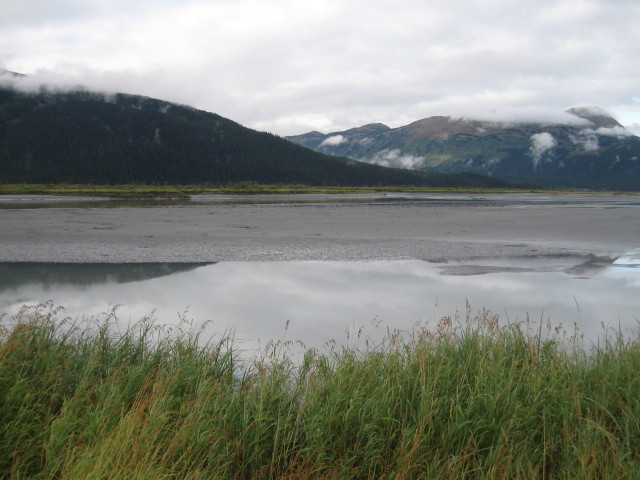
Placer River.
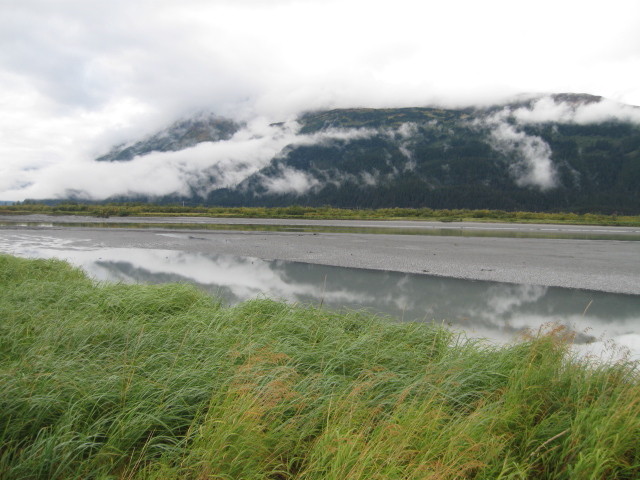
Placer River.
AWCC is involved in some major wildlife
restoration projects. In addition to its efforts to heal and
release injured animals, the facility is an active participant
in restoring the wood bison back into the wilds of Alaska.
Jointly sponsored by the Alaska Department of Fish & Game
and other conservation groups, this effort is scheduled to take
place over the next year or two as the herd at AWCC has
grown quickly over the few years. Gone from the wild of Alaska
for almost 100 years, the restoration of the wood bison, the
largest land mammal in North America, has been underway since
2003. In November of that year, the Yukon Territory donated a
herd to the AWCC, the only wood bison herd in the United States.
The first wood bison calves born in the state of Alaska in over
100 years were born at AWCC in 2005. The herd has continued to
expand through natural birth and via further donations from
Canada. In 2012, almost 40 calves were born to the herd.
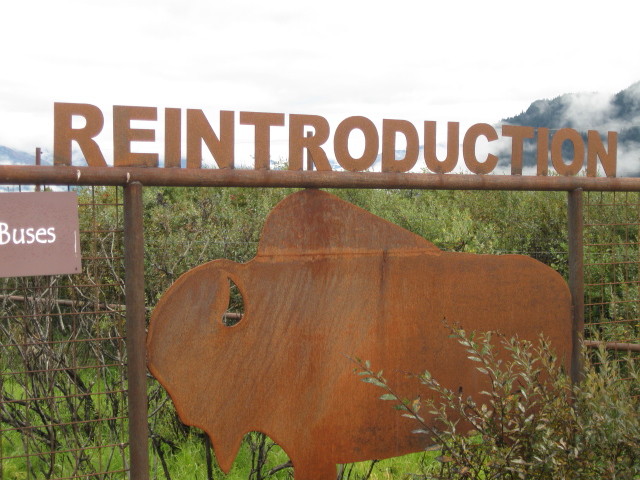
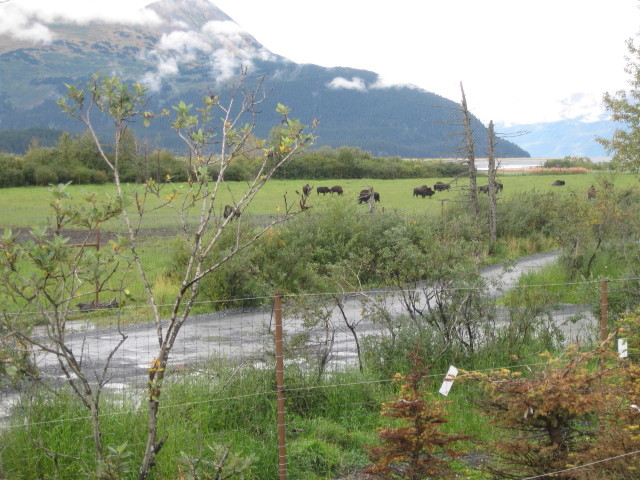
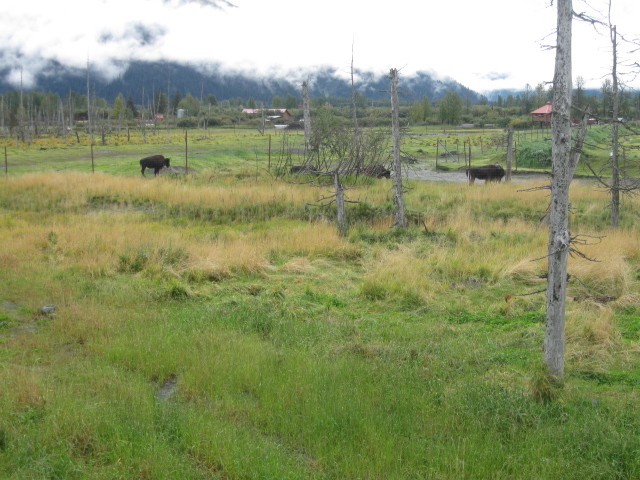
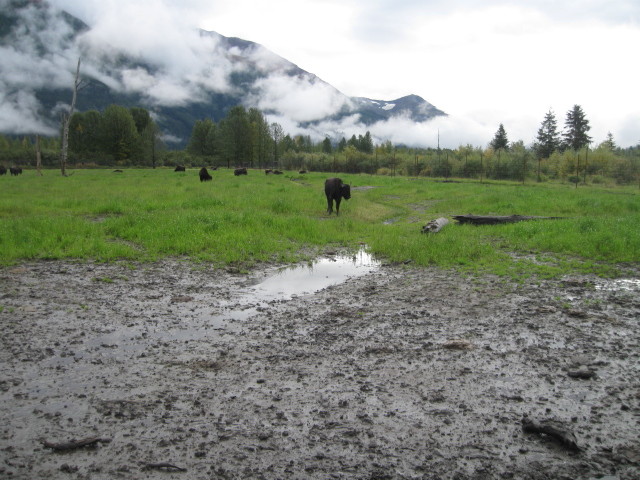
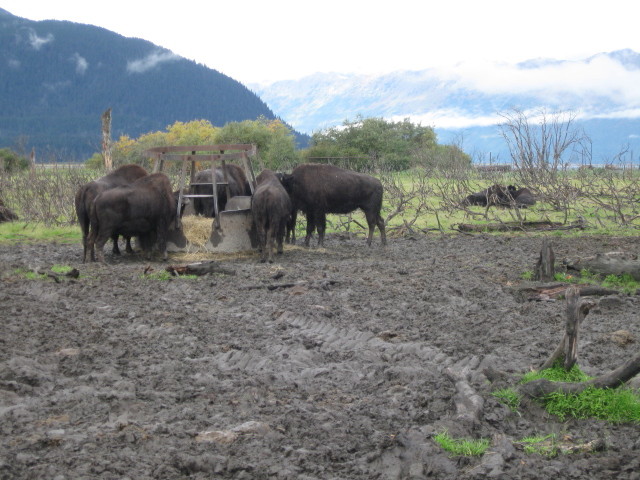
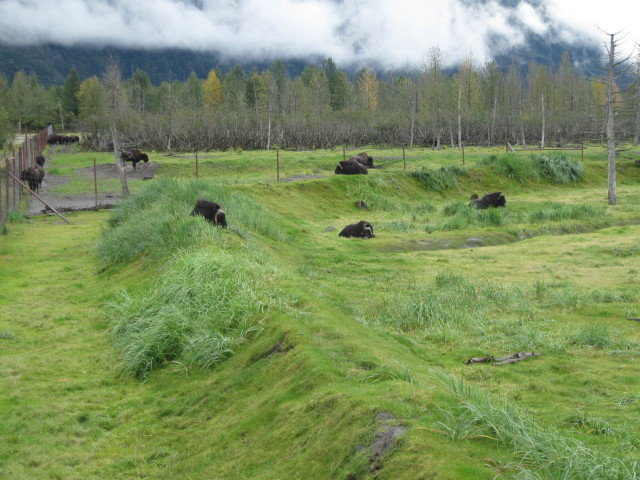
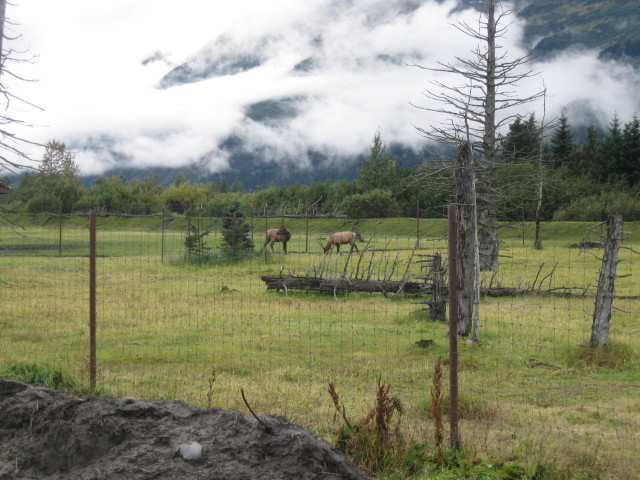
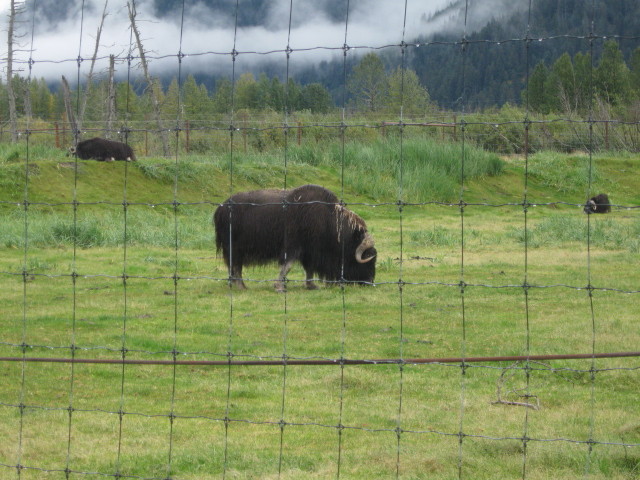
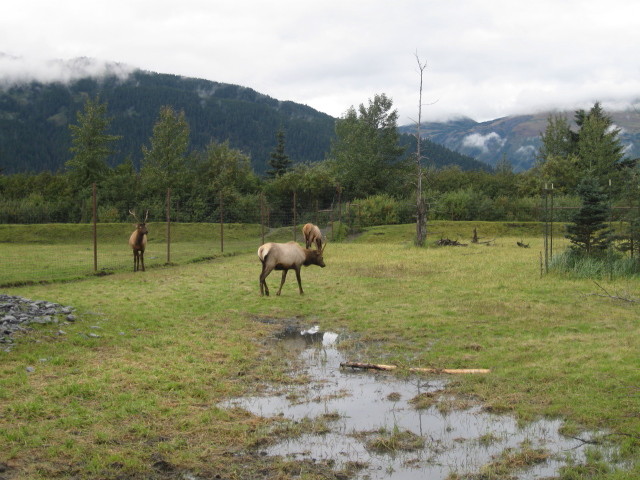
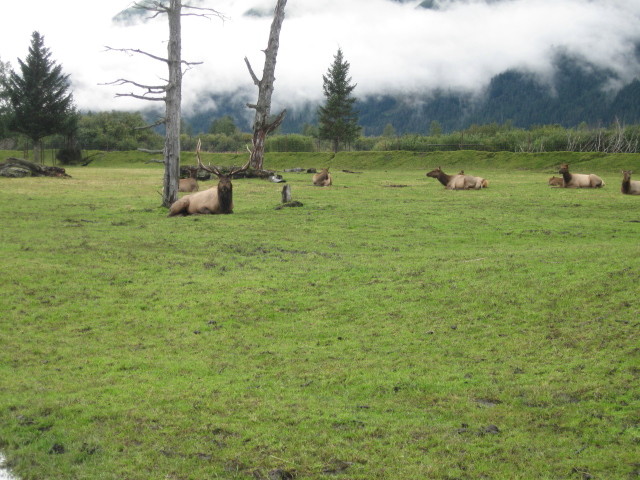
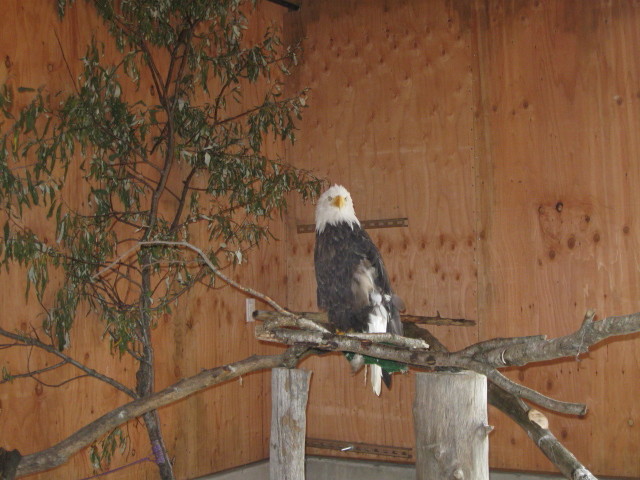
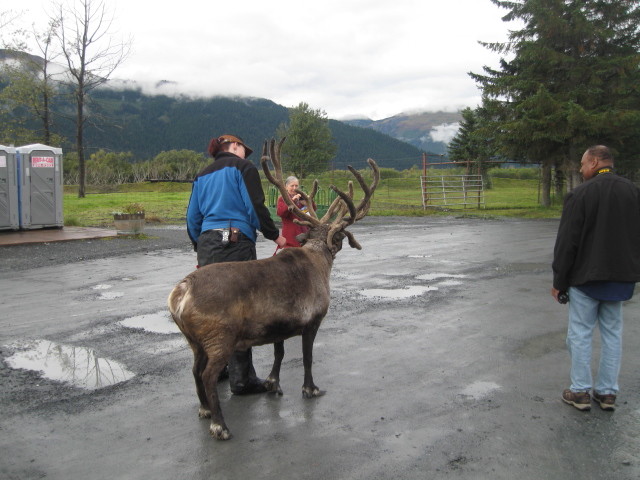
Click Back button on your browser to return
to this page.
After a stop in the gift
shop for some half off sale ice cream it was time to re-board
the bus.
Both driver and Sarah J.
did a census count and when they agreed we left AWCC for our
next adventure.
Garden beds at the AWCC.
Now we were back on our friend, the Seward
Highway heading north toward Anchorage for the last venue and
adventure. Along the trip, I learned that stretches of highways
are built as emergency landing strips. This came about after the
earthquake in 1964.
They saved the best for last !!!
After a 30 minute ride, we arrive at the last
and the best stop of the day. A Grade A+ experience.
In 1954, eleven Girdwood residents
passed the hat and passed the hat and raised enough money to
purchase what became the land base for a major ski area. Through
initiative and perseverance, they developed a ski area that was
small in assets but big in promise. They found a French Baron
who shared their dream. Francois de Gunzburg installed a Poma
chairlift, built ski trails and a day lodge and ordered Chair 1,
a 5,700-foot double chairlift that rose 2,000 vertical feet.
Today, the Alyeska Resort is considered
by many to be Alaska's premier year-round resort, featuring the
304-room Hotel Alyeska. The hotel, built in a chateau-style,
opened in 1994. Today, it is a favorite for winter sports, with
an average snowfall of 650 inches, and summer outdoor
activities. Alyeska Resort sits in the heart of Girdwood, a
glacier carved valley. To the west and north, the mountains of
the Chugach State Park provide a stunning backdrop over Alyeska.
At 495,000 acres, it is the third largest state park in the US.
During the winter, the Alaska Railroad often operates a ski
train to Girdwood for the Alyeska slopes.
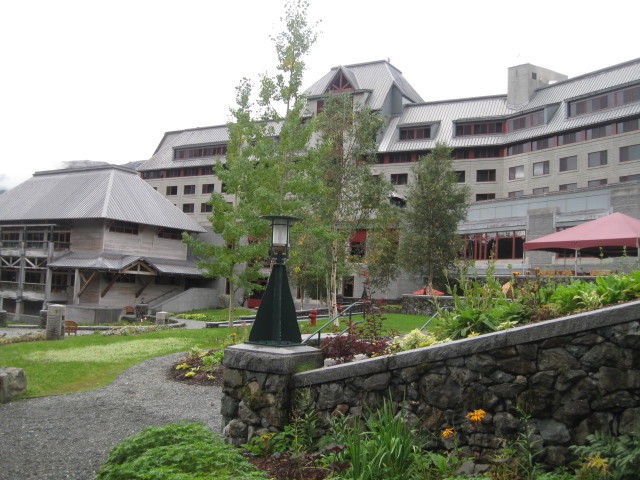
Hotel Alyeska.
GPS: 60 58.224, -149 05.810
Click
to see map.
Click Back button on your browser to return to this page.
elev:
266'
The Alyeska Resort Aerial Tramway was
designed by Von Roll Tramways, Inc of Switzerland. It has a
regenerative drive system. AC power is converted to DC, allowing
the tram to operate at varied speeds - slow for scenic riders
and fast for powder days. In the winter, the tram operates at
full speed. In the summer, the tram is operated at half speed,
allowing ample time to enjoy the natural beauty of the area and
to spot wildlife. The tram operates two cars on a counterweight
system - one car goes up the other car comes down. It takes you
to the top of mount Alyeska at 2,300 feet above sea level. This
seven-minute ride takes passengers to the mountain's viewing
deck with breathtaking panoramic views of mountains, hanging
glaciers, streams, spruce and an array of wildlife. Telescopes
on the Glacier Terminal viewing deck intensify what Conde' Nast
Traveler Magazine rated the best view of any U.S. ski resort.
Before leaving the bus, the "Lunch Princess" told us the plan
while we were here. After our tram ride. we will have our box
lunch on the Hotel Alyeska patio. But before our tram ride, we
will have a docent led tour of the machine room. The docent meet
and welcomed us to the Tramway. He then led us to the machine
room. It was sort of secret passageway to enter the machine
room. We went thru a two door elevator. Neat. In the front door
and out the back door.
Not a large room. Above the ceiling is the
platform for car loading.
The docent gave a great talk about the workings and mechanics of
operating the Tram. He also told about how resort hotels, ski
lifts and the railroads were inter involved and related. After
the tour we proceed to the loading platform. As our group was
just about all the riders for the tram, we split in to several
smaller groups to go up to the top. This would give more room
and better viewing in the cars.
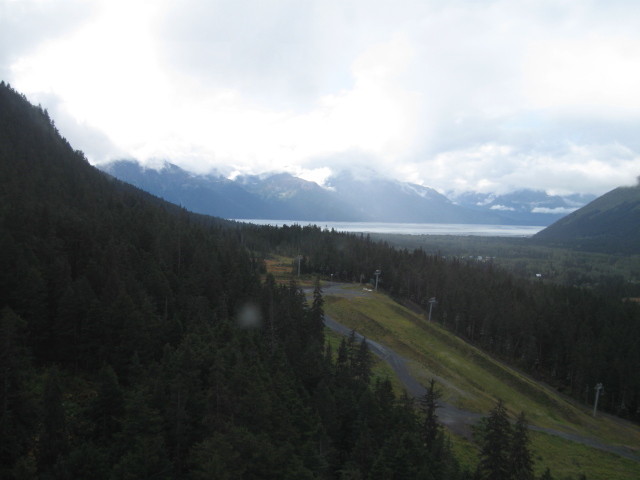
Turnagain Arm in the distant.
As the car climbs to the top, we notice that
a lot of trees have a curve or bow in the trunks about three to
six feet above ground. The guide explains that is due to the
almost 700" of snow fall each winter that the snow pushes the
trunks in a downhill direction slowly bending the trees. We also
notice a trail up the side of mountain with a lot of switch
backs going directly under the tram route. This the guide
explained was where the annual run up the mountain was held. We
had missed this years run by several weeks. During a 24 hour
period, runners see how many times they can go up the mountain.
This year's male winner did 12 trips and the female winner
completed 11 trips in 24 hours.
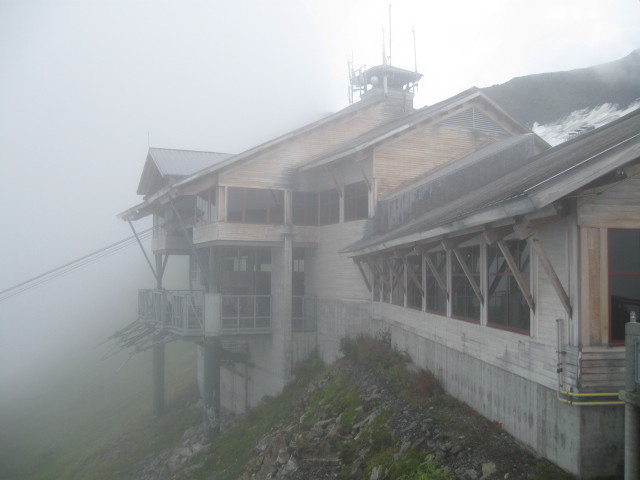
Upper Tram Terminal.
GPS: 60 57.685, -149 04.804
Click
to see map. Click Back
button on your browser to return to this page.
elevation: 2334.'
The Glacier Express restaurant is a
self-service restaurant with gift shop on far right.

Construction being done on back side of Upper Tram Terminal.
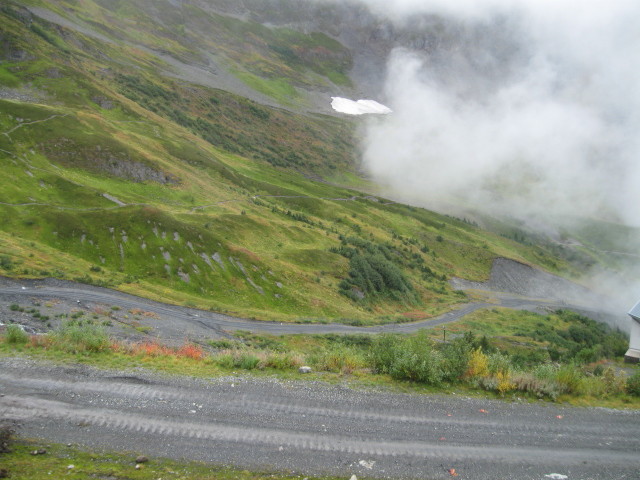
More of back side of tram station.
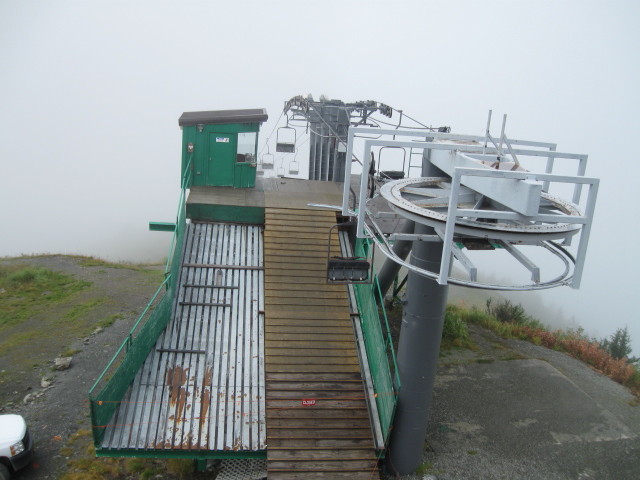
Chair Lift.
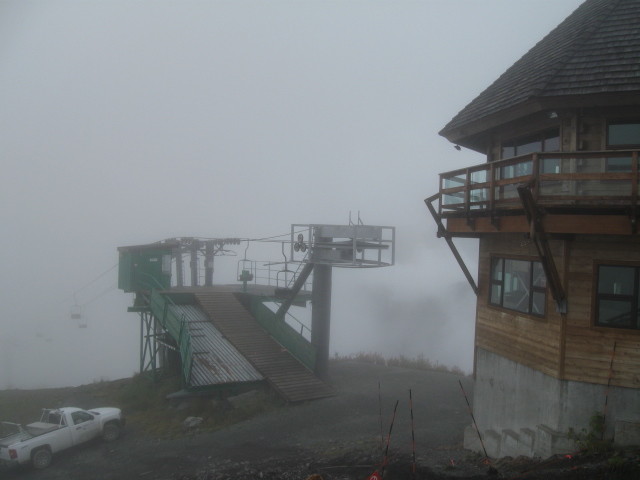
Chair lift and gift shop.
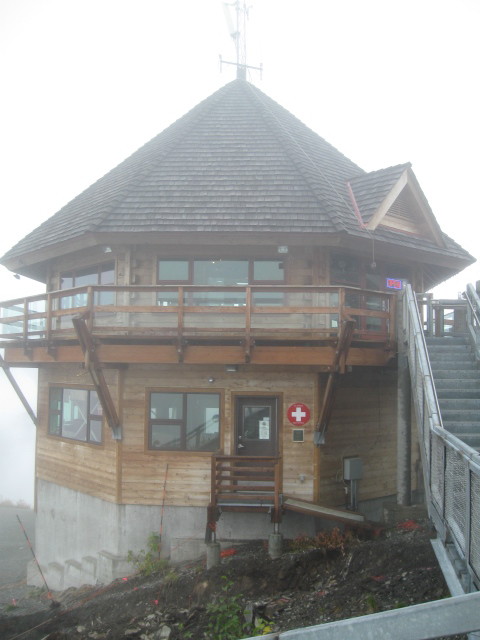
Gift shop and First Aid.
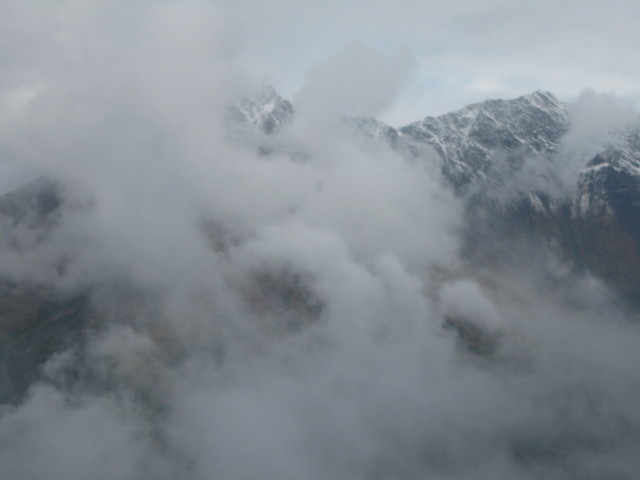
View from front of Upper Tram Terminal.
Back side of Upper Tram Terminal.
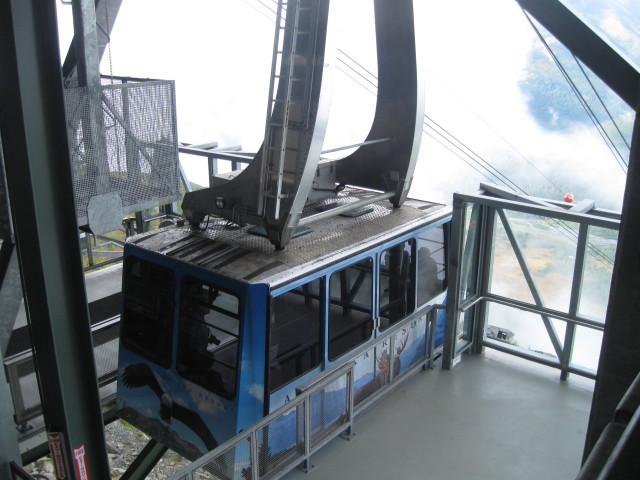
Car at Upper Terminal.
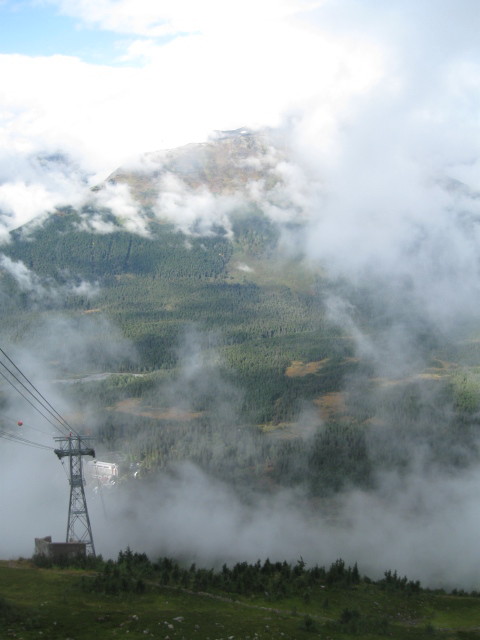
Hotel Alyeska at Lower Tram Terminal.
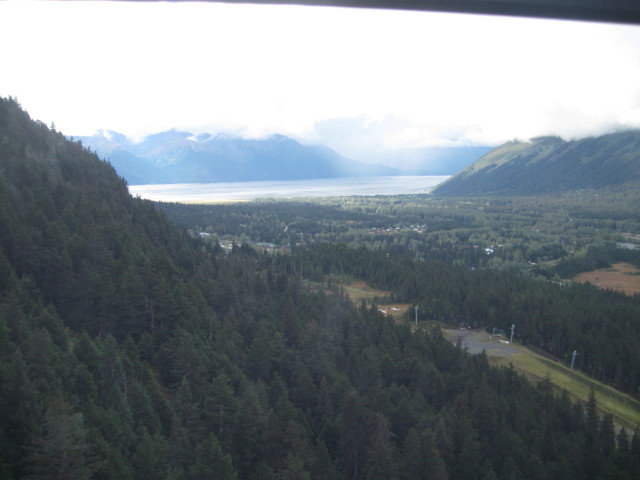
Turnagain Arm with the town of Girdwood near water's edge.
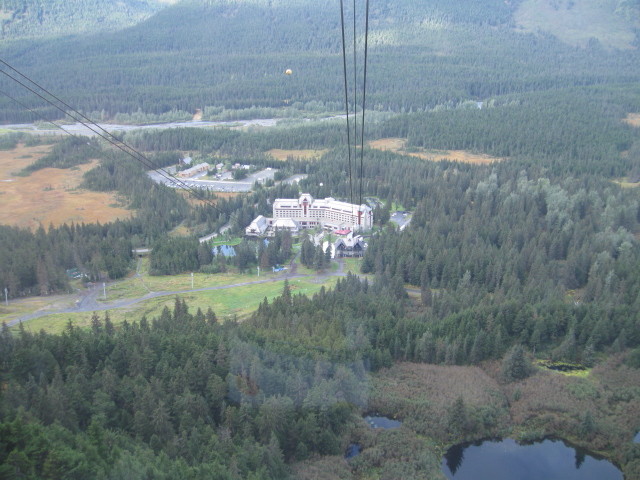
Hotel Alyeska.
The car operator was asked
when is the best skiing time of the season. His reply was that
the sweet spot was in late March and April. There was more
daylight then and the snowing had stopped he said.
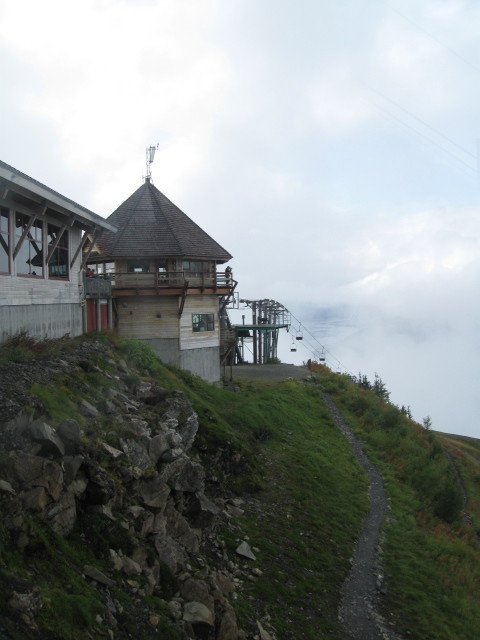
One last look.
Tram stats provided by the resort;
Maximum Speed: 26 miles per hour (42 kilometers per hour)
Average Time: 4 minutes in the winter and up to 7 minutes in the
summer
Capacity: Each of the two cars holds a maximum of 60 persons.
The maximum in the winter in 800 persons per hour.
Elevation: Lower Tram Terminal: 306 feet (93 meters)
Upper Tram Terminal: 2,334 feet (711 meters)
Vertical Rise: 2,025 feet (617 meters)
Length of Span: 3,869 feet (1179 meters)
After arriving at the Lower Tram
Terminal it was time to find our "Lunch Princess."
Hotel patio where our box lunches were being served.
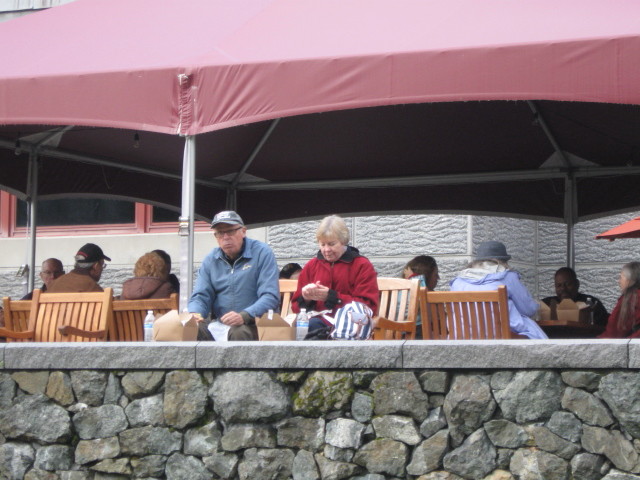
Enjoying a great box lunch and fabulous view. Sarah J. said
the Hilton Anchorage prepared these and I think they are best
we had so far.
Lower Tram Terminal with temporary summer
tent to the right. Used for concerts and dances.
After a enjoyable lunch break, we were led on
a walking tour thru the hotel to our waiting bus.
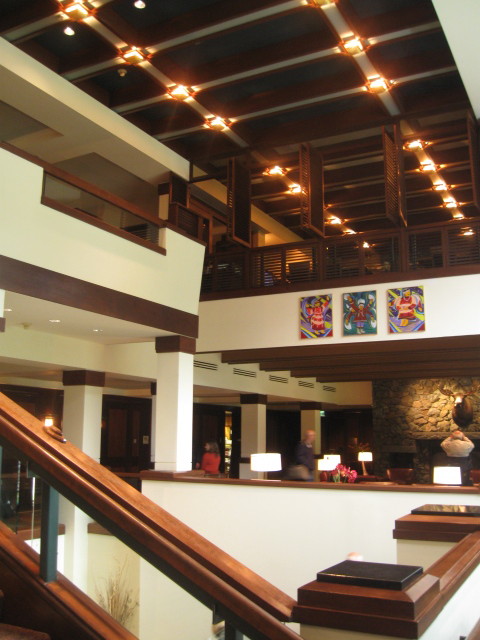
The Hotel Alyeska lobby.
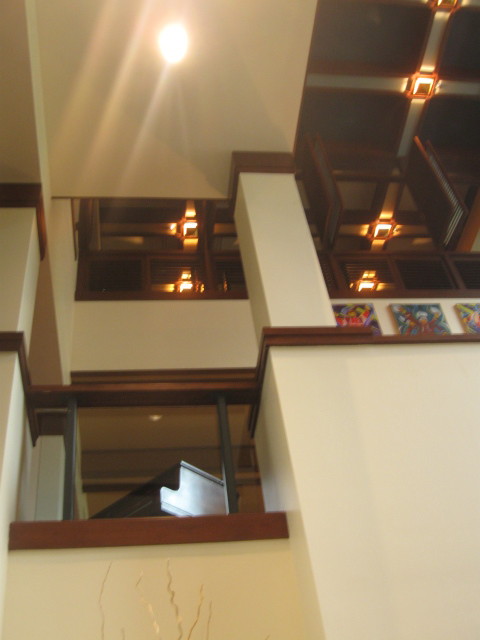
Lobby
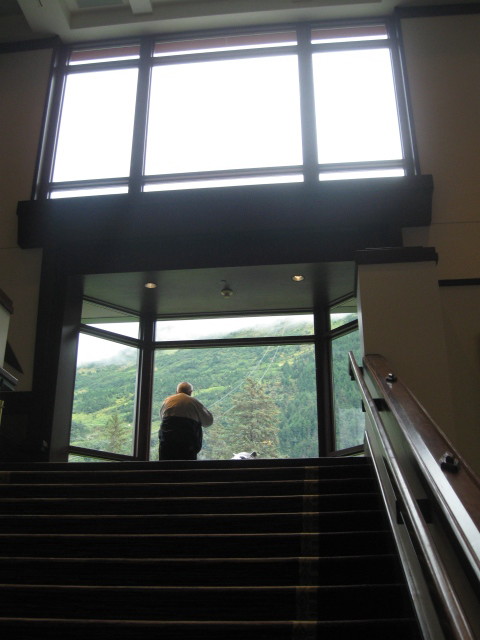
Grand staircase.
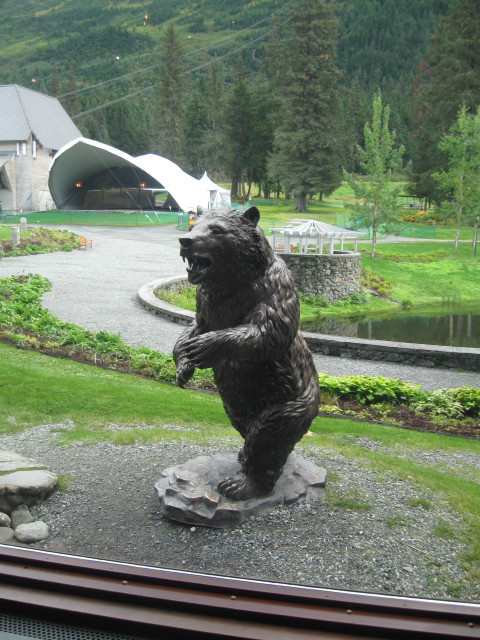
On the outside looking in.
NRHS listed at top of today's hotel
calendar.
Lobby display.
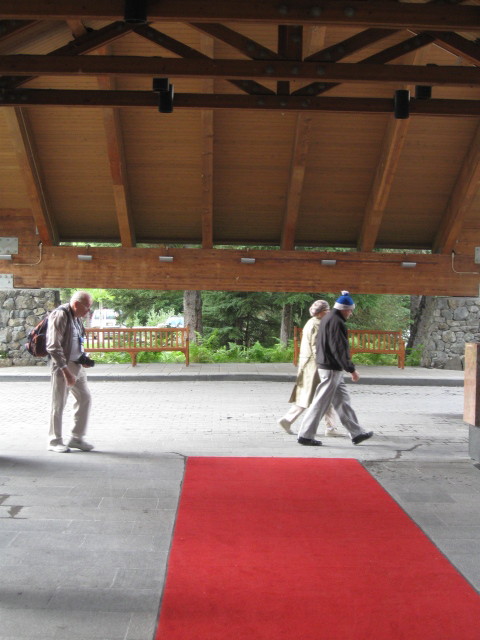
Leaving the hotel front entrance via the red carpet to the
porte-cochere.
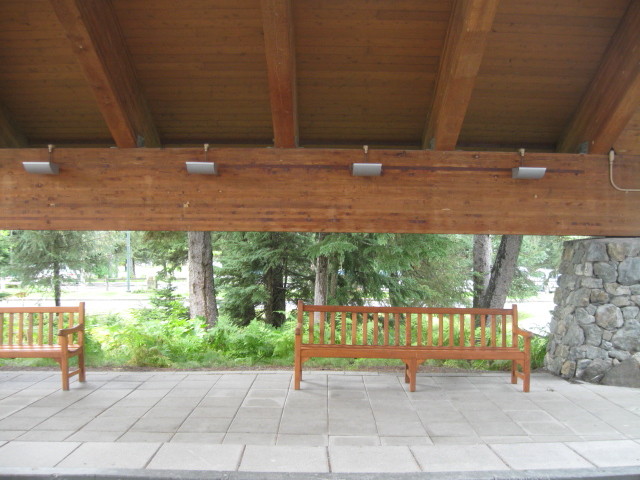
Under the porte-cochere.
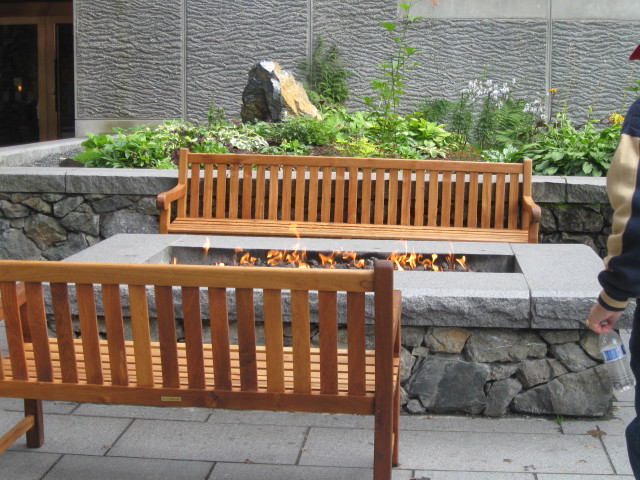
Just outside at the front entrance.
Front entrance driveway with our bus
waiting.
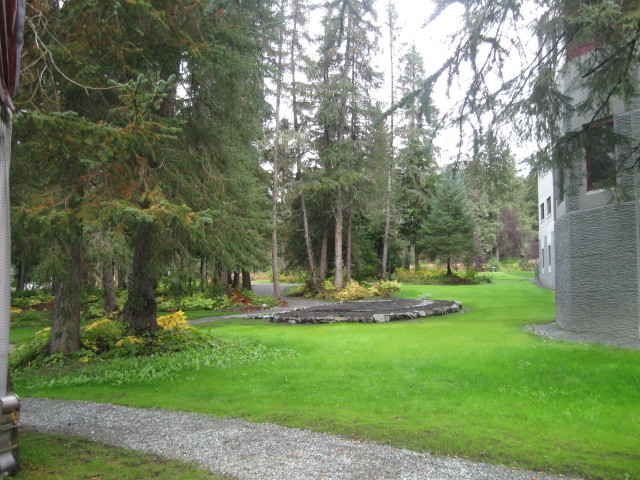
View of hotel side lawn
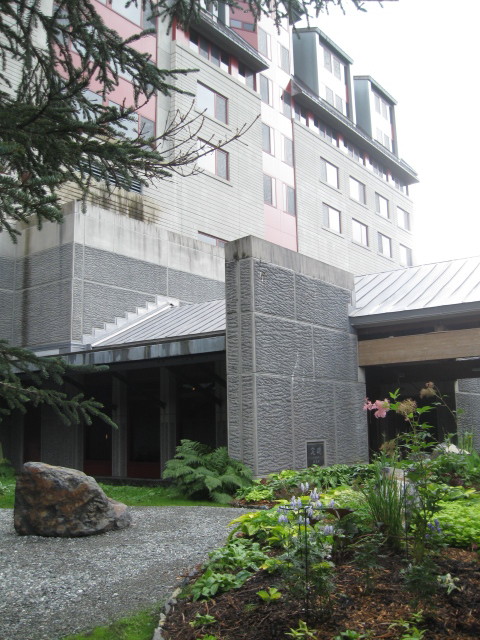
Main Entrance and walkway.
At 3:30 PM, it is time to leave this three
diamond resort hotel. Plan to talk to my siblings about coming
here for a family reunion and winter ski holiday.
We travel thru Girdwood to the Seward Highway for our northbound
trip to Anchorage. While on the highway we encounter several
slow downs and detours due to road work and repair. The bus
driver said that due to the short warm repair season in Alaska
that road work was a 24-7 schedule to get as much work done as
possible. Lots of good jobs up here for road workers and many
come here to work and then return home at end of season.
As we approach Anchorage the driver said that we missed the
hanging flower baskets by just a couple of weeks. Each summer
the city is beautifully decorated with almost 100,000 hanging
flower baskets brimming with brightly-colored blooms. At the end
of summer the baskets are taken downed and stored until next
summer.
While waiting at a stop light, the driver notices an unmarked
police car. He states that the FBI Anchorage office is the
largest in the world. A great many residents here are involved
in national security either directly or indirectly.
As we approach downtown, we go down 5th Ave past my hotel.
Wouldn't been nice if I could have been dropped off here in
front of my hotel. Turning off of 5th Ave we go pass the Hotel
Captain Cook, the driver tells us this was the first high rise
hotel to be built and had many financial problems in getting
started and with construction.
Minutes later the bus arrives at the Hilton and I leave it and
walk back to my hotel. I meet up with fellow hotel friends and
plan tonight's schedule. Two important tasks were laundry and
supper. The Guesthouse Anchorage Inn has a small laundry room
for guest. It has two washers and two dryers in a locked
room.Therefore only one guest at a time can use the laundry. You
make reservation at the front desk and receive the key, do your
wash and then return key. Elizabeth A. would go first and do her
wash before dinner. Chris P. and I would go to dinner and then I
would do my wash then Chris P. his. Chris and I decide to go
across the street for dinner at the Sizzlin Cafe. It was a good
meal and we both had the Cobb salad. Then it was time to pick up
the laundry room key and a roll of quarters. Afterwards it was
good to have an all clean wardrobe.
Then it was lights out on my first full day
in Anchorage, Alaska.
FYI Links: Click Back
button on your browser to return to this page.
Begich, Boggs Visitor Center, Glacier Ranger
District
http://www.fs.usda.gov/detail/chugach/home/?cid=stelprdb5251094
Visitor
Center
Alaska Wildlife Conservation Center
www.alaskawildlife.org
Alaska
Wildlife Center
Hotel Alyeska
http://www.alyeskaresort.com/
Hotel Alyeska
Guesthouse Anchorage Inn
321 E. 5th Ave
http://www.guesthouseintl.com/hotels/anchorage
Guesthouse
Anchorage Inn
Sizzlin Cafe
346 E. 5th Ave
http://guesthousealaska.com/?page_id=15
Sizzlin Cafe
